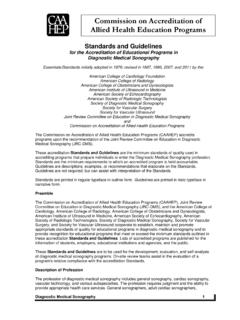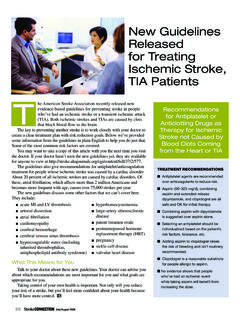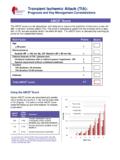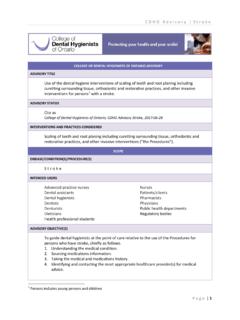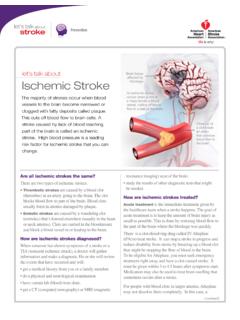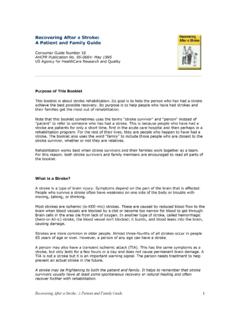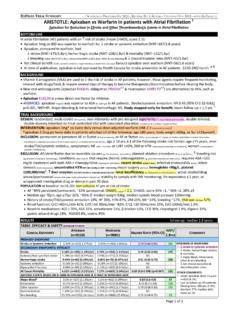Transcription of National Education Curriculum
1 National Education Curriculum Specialty Curricula Vascular Technology Copyright 2016 Joint Review Committee on Education in Diagnostic Medical Sonography (JRC-DMS). All rights reserved. 2 Return to Table of Contents Table of Contents Section I: Fluid Dynamics .. 3 Section II: Physiology and Hemodynamics .. 4 Section III: Physical and Electrical Principles .. 8 Section IV: Cerebrovascular .. 10 Section V: Peripheral Venous .. 17 Section VI: Peripheral Arterial .. 23 Section VII: Abdominal/Visceral .. 31 Section VIII: Miscellaneous Conditions/Tests .. 37 Section IX: Quality Measurements .. 46 Section X: Sonography Safety .. 47 Abbreviations .. 48 Utilized References .. 50 Vascular Technology Copyright 2016 Joint Review Committee on Education in Diagnostic Medical Sonography (JRC-DMS).
2 All rights reserved. 3 Return to Table of Contents Section I: Fluid Dynamics Rationale: Accurate, appropriate, noninvasive vascular examinations require knowledge of sonography physical principles and instrumentation, hemodynamics and the pathophysiology and treatment of vascular disease. The application of this knowledge to standardized diagnostic test protocols, correlation of test data with other recognized imaging modalities, and an ongoing quality assurance program is requisite to quality patient care. 1. Define power, work, and energy 2. Describe the differences between potential and kinetic energy 3. Explain the importance of hydrostatic pressure in the human circulatory system 4. Describe the relationship between volumetric flow and blood flow velocity 5.
3 Define capacitance and compliance 6. Explain the impact of variations in fluid viscosity on blood flow 7. Describe the components of Poiseuille s law and Bernoulli s principle I. Fluid Dynamics A. General Description 1. Flow and related terms 2. Power, work and energy 3. Potential and kinetic energy 4. Hydrostatic pressure 5. Volumetric flow 6. Velocity 7. Capacitance 8. Compliance 9. Fluid viscosity B. Derivation of Equations 1. Describe a. Resistance equation b. Volumetric flow equation (continuity equation) c. Simplified law of hemodynamics d. Pressure/flow relationships i) Poiseuille s law ii) Bernoulli s principle Conservation of energy Bernoulli s equation o Equation with hydrostatic pressure term o Equation with heat term iii) Reynold s number e.
4 Relationship of equation components to each other C. Description of Steady Flow 1. Rigid tube 2. Curved tube Vascular Technology Copyright 2016 Joint Review Committee on Education in Diagnostic Medical Sonography (JRC-DMS). All rights reserved. 4 Return to Table of Contents Section II: Physiology and Hemodynamics 1. Explain the relationship between pressure, flow and resistance 2. Define and describe high resistance and low resistance flow profiles 3. Relate the difference between steady and pulsatile flow 4. Describe the changes in pulsatility of flow that occur with vasoconstriction and vasodilation 5. Describe normal and abnormal flow profiles that occur in the arterial and venous systems 6. Correlate flow profiles to pressure, flow and resistance 7.
5 Define systemic versus autoregulatory control of peripheral resistance II. Physiology and Hemodynamics (Pulmonary versus Systemic) A. Pressure and Flow Resistance 1. Left heart a. Stroke volume b. Cardiac output i) Ejection fraction ii) Pre-load and after-load c. Cardiac cycle d. Electrical conductivity i) Relation to waveform morphology 2. Peripheral arterial system a. Vessel sizes b. Arterial resistance i) High resistance ii) Low resistance c. Volume flow changes i) Effects of vessel diameter ii) Anatomy iii) Pathology iv) End-organ perfusion d. Effective resistance in peripheral arterial system i) Arteries ii) Arterioles iii) Capillaries 3. Peripheral venous system a. Vessel diameter b. Anatomy c. Pathology d. Effective resistance in the peripheral venous system Vascular Technology Copyright 2016 Joint Review Committee on Education in Diagnostic Medical Sonography (JRC-DMS).
6 All rights reserved. 5 Return to Table of Contents i) Vena cava ii) Peripheral veins iii) Venules 4. Right and left heart a. Effects on peripheral flow patterns b. Pulmonary hemodynamics 5. Cardiovascular system a. Velocity versus cross-sectional area b. Pressure changes in arterial system i) Arteriolar regulation ii) Change in pulsatility waveforms iii) Vasoconstriction/vasodilation c. Pressure changes in venous system i) Venous pressure ii) Venous capacitance and static filling pressure iii) Hydrostatic pressure iv) Calf muscle pump v) Respiratory related changes vi) Venous resistance and transmural pressure vii) Venous hypertension and edema B. Arterial Hemodynamics 1. Total energy a. Potential i) Hydrostatic ii) Gravitational b. Kinetic c. Conservation of energy 2.
7 Energy gradient a. Definition b. Effects on flow c. Effects of cardiac output and peripheral resistance 3. Resistance a. Effects of viscosity, friction, inertia b. Blood in a non-Newtonian fluid c. Autoregulatory versus sympathetic 4. Application of pressure/flow relationship a. Poiseuille s law i) Vessel length ii) Vessel radius b. Reynolds number 5. Application of flow/pressure/velocity relationship Vascular Technology Copyright 2016 Joint Review Committee on Education in Diagnostic Medical Sonography (JRC-DMS). All rights reserved. 6 Return to Table of Contents a. Bernoulli s principle 6. Steady versus pulsatile flow 7. Doppler flow profiles a. Flow patterns i) Laminar Plug Parabolic ii) Disturbed iii) Turbulent b. Waveform morphology i) Triphasic ii) Monophasic iii) Systolic upstroke iv) Systolic deceleration v) Diastolic component c.
8 Pressure pulse distortion 8. Effects of stenosis/occlusion on flow characteristics a. Definition of hemodynamic significant stenosis i) Flow versus pressure gradient b. Direction of flow, turbulence, disturbed flow c. Velocity acceleration/deceleration d. Entrance/exit effects e. Diameter reduction f. Peripheral resistance g. Collateral effects h. Effects of exercise i. Effects of occlusion C. Venous Hemodynamics 1. Total energy a. Potential i) Hydrostatic ii) Gravitational b. Kinetic c. Conservation of energy 2. Venous resistance 3. Pressure/volume relationships a. Pressure gradient b. Respirophasicity c. Effects of calf muscle pump mechanism i) Rest Vascular Technology Copyright 2016 Joint Review Committee on Education in Diagnostic Medical Sonography (JRC-DMS).
9 All rights reserved. 7 Return to Table of Contents ii) Contraction iii) Relaxation d. Obstruction/resistance e. Venous insufficiency i) Duration of reflux ii) Venous hypertension f. Cardiac cycle 4. Effects of edema 5. Doppler flow profiles a. Continuous/non-phasic b. Phasic i) Respiration ii) Heartbeat c. Pulsatility Vascular Technology Copyright 2016 Joint Review Committee on Education in Diagnostic Medical Sonography (JRC-DMS). All rights reserved. 8 Return to Table of Contents Section III: Physical and Electrical Principles 1. Relate the difference between ultrasound energy and power 2. Describe the types of graphic recording used in noninvasive vascular testing 3. Explain methods for calibrating sonographic imaging systems and plethysmographic instruments 4.
10 Define alternating current (AC) versus direct current (DC) coupling, and explain the potential artifacts associated with inappropriate use 5. Understand the most common units of measure associated with noninvasive vascular testing 6. Describe the most common tests used for evaluation of tissue mechanics and pressure transmission in the peripheral venous and arterial systems 7. List the types of plethysmography and pressure assessments used for evaluation of the peripheral arteries and veins 8. Explain the relationship between Ohm s Law and hemodynamics III. Physical and Electrical Principles A. General 1. Energy 2. Power a. Relationship to flow dynamics 3. Ohm s Law a. Description b. Relationship to flow dynamics 4. Graphical recording a. Sweep speed 5.

